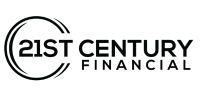Where to Start
Life is unpredictable. Even with a solid financial plan, unexpected expenses such as medical emergencies or urgent home repairs can arise, leaving you unprepared. That’s where an emergency fund comes in. At 21st Century Financial, we understand the importance of securing your financial future. Whether you’re revamping your budget or looking to improve your savings strategy, we’re here to guide you.
Why an Emergency Fund is a Must-Have
An emergency fund acts as a financial safety net, helping you address unforeseen events without slipping into debt. At 21st Century Financial, we encourage everyone to prioritize building an emergency savings account. This fund allows you to stay on track with long-term goals, such as saving for retirement or purchasing a home, even when life throws challenges your way. Unlike discretionary spending, an emergency fund is a crucial resource that ensures financial stability during tough times.
Step 1: Set a Clear Savings Goal
- Determine Your Savings Target
Experts, including those at 21st Century Financial, recommend saving 3 to 6 months’ worth of living expenses. This will help cover essential costs in case of job loss or unexpected emergencies. Here’s how you can determine the amount you need: - Estimate Your Monthly Essentials
List your necessary expenses—such as rent, mortgage payments, utilities, food, and transportation. These are the non-negotiable costs you need to maintain your lifestyle. - Customize Based on Your Situation
Multiply your monthly expenses by 3 to 6, depending on factors like job stability, family size, and any health concerns. If you are self-employed or have dependents, you may need a six-month buffer. The goal is to create a fund that matches your personal needs and situation. - Adjust as Needed
Remember, this target is a guide—not a fixed rule. Start with a manageable goal, and you can build on it over time. 21st Century Financial can help you identify the savings plan that aligns with your specific goals and needs.
Step 2: Start Small and Stay Consistent
Building an emergency fund can seem overwhelming, especially when working within a budget. However, even small contributions add up over time. The key is consistency.
- Set a Monthly Savings Goal
Review your budget to determine how much you can comfortably set aside each month. Even a small amount can make a difference if saved regularly. - Automate Your Savings
Schedule automatic transfers from your checking to your emergency savings account. Automation ensures that you stay on track without missing any contributions. - Take Advantage of Windfalls
Use bonuses, tax refunds, or gifts to boost your emergency fund. Instead of spending these windfalls, allocate them to your savings to reach your goal faster. - Stay Dedicated
At 21st Century Financial, we encourage clients to start small but remain committed. Over time, even modest amounts will grow into a significant financial safety net.
Step 3: Choose the Right Account for Your Fund
Selecting the right type of account is essential to ensure your emergency savings are easily accessible yet protected from unnecessary withdrawals. Here are some options to consider:
- High-Yield Savings Account
This type of account offers better interest rates than traditional savings accounts, while still allowing easy access to your funds when needed. - Money Market Accounts
Money market accounts often provide higher interest rates than regular savings accounts and may offer check-writing privileges, giving you a balance between accessibility and earnings. - Certificates of Deposit (CDs)
CDs may offer higher interest rates but require you to lock in your savings for a fixed period. Consider a laddered CD strategy to ensure some funds remain accessible without penalties.
When choosing an account, balance the interest rate with accessibility. 21st Century Financial offers several account options to suit your savings needs and will help you select the one that fits your goals.
Step 4: Protect Your Fund from Temptation
Your emergency fund is not meant for vacations or non-essential expenses. Here are a few tips to ensure your savings remain intact:
- Keep It Separate
Store your emergency savings in a dedicated account to avoid using the funds for impulsive purchases. - Name Your Account
Label the account with a meaningful name, such as “Emergency Fund,” to serve as a reminder of its purpose every time you check the balance. - Review Your Plan Regularly
Life circumstances change, and your savings strategy should evolve accordingly. Reassess your emergency fund periodically and replenish it promptly if used.
At 21st Century Financial, we emphasize the importance of financial discipline. Protecting your emergency savings is essential for long-term financial security.
Step 5: Keep Growing Your Fund
Once you reach your initial savings goal, consider expanding your fund to provide additional security. As your income and expenses grow, adjust your emergency fund to match your changing financial landscape.
Review your savings annually and make necessary adjustments based on lifestyle changes or new financial commitments. 21st Century Financial can support you in maintaining and growing your emergency fund over time.
How 21st Century Financial Can Support Your Journey?
Building an emergency fund is a vital step toward financial independence. At 21st Century Financial, we offer high-yield savings plans and automated savings options to make your journey smooth and effective.
Is it time to secure your financial future? Contact 21st Century Financial today to explore our savings solutions and start building your emergency fund. With the right plan and guidance in place, you’ll be prepared to face life’s uncertainties with confidence.
Creating an emergency fund isn’t just about saving money—it’s about creating peace of mind. Start small, stay consistent, and let 21st Century Financial help you build the financial security you deserve.

